Community
The History of Michigan Center
In the spring of 1829, Michigan Center was unheard of. It was located in what was soon to be named the "Township of Jackson." A few white settlers had trekked through the wild country on their way west, but only a very few had stayed. The area was swamp land, wooded and wild. The farmers, for the most part, tried to raise their living on the land. About once a month supplies were carried by covered wagon from Jackson where peddlers stopped at the various homes with their wares, which included groceries, yard goods, needles, thread, carpet warp, beaters, tacks, hand tools, etc. This was a big occasion and the entire family would gather to select their needs from the vast store the "peddler" had to offer. One hears of the sawmill built in 1831 by Joab Page (the first in Jackson County, the flour mill put into operation by Ira Kellogg, the store operated by H. Palmer and the first "neighborhood school" opened in 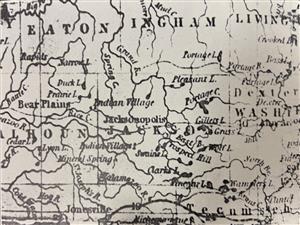 1833. Where these places were precisely located is hard to say, for Leoni and Centre were considered one "town" in this wilderness and memories were about the only records kept. It was 1837 when the first official records of Michigan Centre were recorded with Able Fitch and Paul Ring putting their ambitions on paper in the form of a Platt of Michigan Centre.
1833. Where these places were precisely located is hard to say, for Leoni and Centre were considered one "town" in this wilderness and memories were about the only records kept. It was 1837 when the first official records of Michigan Centre were recorded with Able Fitch and Paul Ring putting their ambitions on paper in the form of a Platt of Michigan Centre.
Even though the Centre had been platted, bands of Indians still roamed the territory and in the year 1837, one year after the Township of Leoni was founded, history records the famous kidnapping of a young five-year old white child named William Filley from there. He is said to have traveled for 29 years with the Indians before returning to Jackson to be reunited with his father.
This was wild country indeed, with pioneers settling every day, building farms, towns, trails, roads and all those things needed to survive. In 1838 Abel Fitch opened the first official post office in the Centre. By 1845 some felt the "Centre" would be the "Capital of Jackson County." So sure of this were Amos Root, Henry C. Orendorff and Ethan Rice that they had come here and established mercantile businesses in the town. This example was followed shortly by Col. Shoemaker when he purchased a mill in the early 1840's to serve the several farmers located in the area. Other early industries included a cider mill, apple jelly factory and a pump factory.
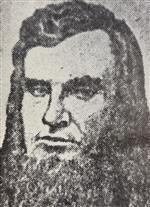 In addition to industrial expansion, social growth was on the increase. On February 16, 1845, Major Abel F. Fitch held a "military and civic ball" in Col. Cowden's assembly room in with all of the dignitaries dress in full military uniforms to celebrate "General Washington's" birthday. The town was growing by leaps and bounds inspired by the pioneering spirit of the day.
In addition to industrial expansion, social growth was on the increase. On February 16, 1845, Major Abel F. Fitch held a "military and civic ball" in Col. Cowden's assembly room in with all of the dignitaries dress in full military uniforms to celebrate "General Washington's" birthday. The town was growing by leaps and bounds inspired by the pioneering spirit of the day.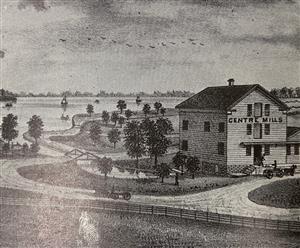
A black cloud came with the railroad in the 1850's, however, when "the Great Railroad War" was waged. The farmers in the area feeling the injustices of the MCRR when their cattle were killed by the trains, began to organize and sabotage the trains on their runs between Michigan Centre and Leoni. In 1850, fifty leading men of the community, including the prominent Abel Fitch, were arrested and taken to Detroit to face charges of setting a $150,000 fire on November 18th at the Detroit freight depot. In the end, most those men sentenced to prison were later pardoned by Gov. Kinsley S. Bingham and the railroad attempted to pay them for damages done to them. It was most likely in these wild and wooly 1850's that the first recorded Michigan Centre school was built on the south side of Broad Street as the land was purchased by the School Board in 1847.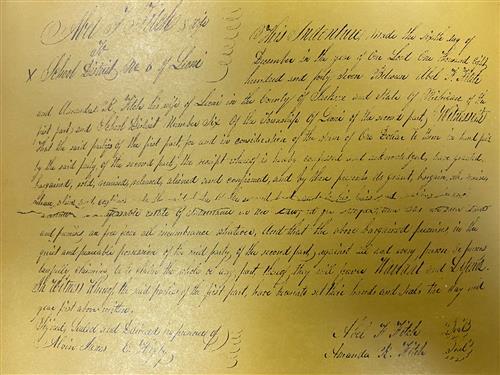
It was described as a wooded structure and as in most cases, it served as a church as well as a school building. What exactly happened to that building is unclear; however, its foundation was discovered years later during the construction of a heating plant for the Keicher School. A Mrs. McClure is said to have been the first teacher in the building. It was also during this time, 1857 to be exact, that the Clement School district was formed and a building constructed.
Surviving the reforms of Horace Mann and others important in education, the year, 1866, recorded a vote to build a new brick school house across the street on Broad Street. Land for this "modern" building was purchased in the year 1867 by the Board.
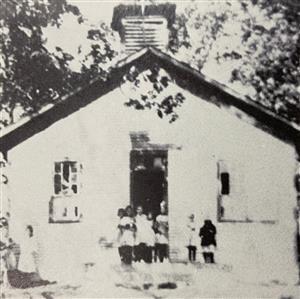 Problems of one sort or another postponed this building, however, until 1869 when Michigan Center's first "school of size" was completed. It was a yellow brick building: the front that housed the belfry being frame. Later it sported a furnace, double desks and "outside plumbing!" Previous histories state that the students "were fifteen in number in this eight - grade school.
Problems of one sort or another postponed this building, however, until 1869 when Michigan Center's first "school of size" was completed. It was a yellow brick building: the front that housed the belfry being frame. Later it sported a furnace, double desks and "outside plumbing!" Previous histories state that the students "were fifteen in number in this eight - grade school.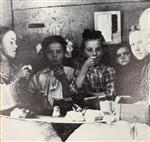
The town itself was continuing to expand also. It now had a barrel factory, known as the "Coopershop", two saloons (which are said to have attracted Jacksons rowdies), besides the post office, the mill and the store. In this same year a Mr. Timothy Pangborn opened a mineral springs at a depth of 237 feet. "It contained minerals prescribed for rheumatism, paralysis and most all ailments." Woody's Smoke House served as the bath house for this with the water being carried from the well in buckets. "Tim's Place" was a popular social gather spot at that time.
Not only were the townspeople bothered by the physical aches and pains of the day, but pains also came within the growing educational system. In 1871 old school records show that there was controversy over whether religious services should be allowed in the "school house." The townspeople, being democratic, took a vote...24 to 13 to allow them to continue.
The next recorded controversy to arise was a law suit over firewood supplied to the school in December of 1885. School records show that apparently someone had been indiscreet in his payment for the wood and the townspeople were out to get the excess money back. A suit was filed and arbitration finally settled the case.
Again in 1887 controversy arose when the school board was instructed by the townspeople to have notices posted forbidding the hitching of horses on school property. Horses were important, but not so important as to be allowed to harm public land.
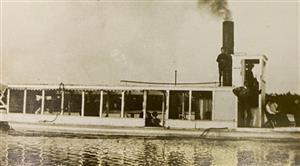 Not only were horses providing transportation for the people, but the railroad was still growing. The MCRR station and ticket office was built around the turn of the century with both the Hawks and Angus(later the DUR) and Boland car lines running through the village. At about the same time, the "Hungry Alice" run by Dan Sauer and George Lombard as an excursion boat carried passengers from the Mill Dam up the lake as far as it was possible to go. Thus much of Center's education was carried on outside confines of the building as well as within the "yellow brick" structure.
Not only were horses providing transportation for the people, but the railroad was still growing. The MCRR station and ticket office was built around the turn of the century with both the Hawks and Angus(later the DUR) and Boland car lines running through the village. At about the same time, the "Hungry Alice" run by Dan Sauer and George Lombard as an excursion boat carried passengers from the Mill Dam up the lake as far as it was possible to go. Thus much of Center's education was carried on outside confines of the building as well as within the "yellow brick" structure.
In 1895 the Center had its own baseball team organized by Joe Noon after he came home from college. This was a community team name the "Michigan Center Barefoot Nine" because they were without shoes and played in their bare feet. Sports had not yet become part of the school, however. they were an important part of life.
By 1914 discussion had begun concerning the building of a new modern school. The school board cussed and discussed the problems many times trying to settle on where it should be, how big, etc. By 1916 they had changed their plans several times settling on a two story building, leaving the location for the townspeople to decide. In the meantime the Michigan Center Congregational Church was used to take the overflow of classes.
In 1918 the two story Broad street building was finally established to house grades one through ten. This new modern building started as a four room school, one of which was a "Red Cross Sewing Room."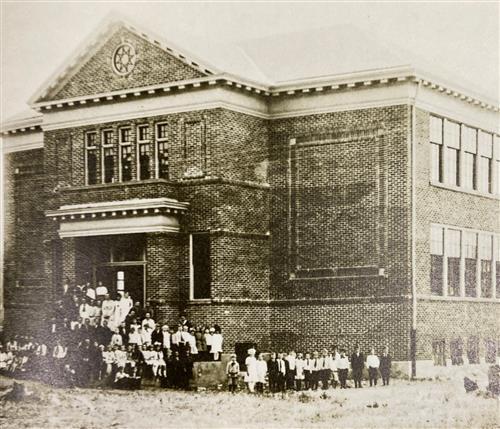
Not only was construction taking place on the new community sports facility, but the "yellow brick" school house was being given a new face. In 1921 the building was covered with red brick (new), a new entrance was built, and indoor toilets were installed! In spite of this modernization kids were still kids, however, for one of the favorite tricks to call off school was to stuff tar paper in the furnace and smoke up the building.
The 1920's saw sports come to the school. In 1924 a girls' basketball team was organized. The following year Michigan Center High School had its first football team organized under Paul "Hop" Orwick and Elvolt "Bing" Proy and basketball made its appearance with Ward "Mac" Scoville as coach.
Baseball, which had been a community sport for some time, first became a school sponsored activity in 1926: however, it did not become a league sport until 1931. In all, the school was rapidly growing and becoming firmly established in the town moving to becoming a K-12 district in two more years. It even had a band organized in the kindergarten in 1926 by Minnie Arnold.
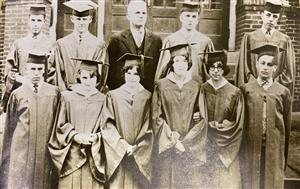 On May 18, 1928 when Michigan Center graduated its first 12th grade class, there were 41 courses offered in grades 7-12, a County Normal School operated in the building, an active PTA had been formed, the first J Hop had been held, and the two buildings had more students than they could hold. As a result of this growth, the school board had negotiated for the use of the Community Building for winter sports, added four more rooms and built a temporary building of two rooms between the new school and the Community Hall. In addition, the Baptist Church was used for classes which would not squeeze in the school's limited facilities.
On May 18, 1928 when Michigan Center graduated its first 12th grade class, there were 41 courses offered in grades 7-12, a County Normal School operated in the building, an active PTA had been formed, the first J Hop had been held, and the two buildings had more students than they could hold. As a result of this growth, the school board had negotiated for the use of the Community Building for winter sports, added four more rooms and built a temporary building of two rooms between the new school and the Community Hall. In addition, the Baptist Church was used for classes which would not squeeze in the school's limited facilities.
Immediately the people started working on plans for additional expansion. On July 13, 1928, an $85,000 bond was authorized by the school board and approved by the voters to add on the eight room structure. This was bitterly fought by a few townspeople, but the courts approved of the school's position in April of 1929. Thus in 1930, in spite of the depression, seventeen rooms and a gym were added to the school building. In this same year a cafeteria was opened to provide meals for students attending school, a high school band was formed, and at the end of the school year the County Normal was moved to Grass Lake.
The next few years continued to be troublesome financially for the townspeople as well as most people in these times of the "Great Depression." At the April through June 1932 school board meetings the board struggled with the budget over in order to find a way to continue school operation. Teachers' salaries were cut by 50%, the cafeteria was closed, the kindergarten building closed and custodians were laid off. In addition, money was borrowed in anticipation of taxes.
A year later, school opening was again questioned. Teachers were offered jobs "if the school opened," insurance coverage was reduced and the extending of bonds was carried out. Times were bad for everyone but the community was working together to survive.
The 1930's were a time of rapid growth in sports and school spirit. In 1935 the student body voted to be called the "redbirds" because of the large number of cardinals visiting the area during the summer months. On December 19th of that year an "all-time football team of 1925-35" was announced following a vote of the fans. By 1936 the first "state championship" in sports had been brought unofficially to the school by the football team. The year 1937 saw the first "official" Michigan Center Track Team compete in the county meet.
Other important social events also began in the 30's. Beginning with the class trip of 1935 to Huron River Drive, senior trips progressed to Chicago and later to Washington, D.C. Junior and senior play became important money raisers for the "trip" as well as a fun activity each year. The annual May Festival, with its activity and frolic, and the circus, which raised money to buy band uniforms, were other social activities held important and entertaining for all.
The 1940's brought more hard times, however, with the war costing much in lives, activities and material things. In 1943 senior trips were stopped, the band was halted, track was discontinued, and in that same year, the Jackson County Victory League was formed because of gas rationing and loss of boys to the armed services. During these years Peter Aleck became well-known and loved by all in Michigan Center for his support of the young. (Fact shared by Gary Redmond: The Farr farm had an airport in the 40’s.)
In 1950 plans were made for the Keicher Elementary School which was completed in 1952. This building was named for Mr. R.F. Keicher, then Superintendent, who remained as head of the system for a total of thirty years. Also in 1950 a group of citizens called the "Michigan Center Boosters Club", constructed, lighted and seeded Michigan Center's first formal athletic field.
Later in the 1950's citizens saw the addition of several classroom and office space to Arnold School and began planning for the future building of a new high school. In 1952 and 1953 the track team was reinstituted and a chorus was organized.
In the year 1955 the name of the district was changed to "Michigan Center School District #6 of Jackson County." In October of 1958 the present two and a quarter million dollar high school was opened to house an enrollment of just over 375. With the move to the new school, the traditions of homecoming, including floats and kings and queens were begun.
Continuing in its growth, the school district annexed the Clement Elementary School in 1962; and the high school became fully accredited by the North Central Association as a quality school. By 1965 two more sports were added to the school: wrestling and cross country. The addition of these two sports expanded the students' opportunities in sports participation. (Fact shared by Gary Redmond: The High school had a Golf club in 1960.)
The district continued to grow through the 1970's at a steady pace. The "new" athletic field was completed in 1967, boy's golf was started in 1968, and in 1970 tennis courts, with the help of the local Rotary Club, were installed for the use of students and other members of the community. Later baseball and softball fields were added to the athletic complex.
In 1972 the first all-school musical, "My Fair Lady," was produced, again increasing the activities available to students. In 1973-74 girls' sports were renewed with the starting of golf, volleyball, track, softball, and the reinstating of basketball: and the following year saw gymnastics added thus providing equal activities for the female gender.
The 1980's saw enrollment decline as it did in most school districts and in the year 1985 the consolidation of buildings began. Jr. High students were moved to the Clement School and into the High School building. The Broad Street building was then used for the district's first Community Education Complex which housed Adult Education classes, Teen Scene, and Senior Citizen activities until 1996. In 1988, continued enrollment decline forced the closing of the Clement building and movement of the students to the remaining three facilities. These reorganizations and the major reductions in programs caused by loss of revenue as well as a teacher's strike stirred much controversy among residents of the district.
In 1993, after a period of turmoil, the voters supported new millage and the State revised it's school funding. The district was again stabilized and began to rebuild it's tradition of strong facilities and programs. The Jr. High was established as a "school within a school" within the High School facility, having it's own schedule, curriculum and physical area. Major renovations were made to all facilities in the district, much needed new texts were purchased and over $150,000 was spent on modern technology.
What is the future of Michigan Center Schools? No one really knows. Several thousand graduates can attest to the quality education they have received in the past and to the many fond memories they hold. No one can take these away. To quote Daniel Webster:"If we work on marble, it will perish; if on brass, time will efface it; if we rear temples, they will crumble into dust; but if we work upon immortal minds and imbue them with principle, with the just fear of God and love of our fellowmen, we engrave on those tablets something that will brighten to all eternity.."
Written by James G. Reasoner, 1996
Copyright (c) 1996
